Progress report for FNE23-042
Project Information
This project seeks to:
- Establish diverse perennial plantings of cup plant, Eastern gamagrass and plantain/birdsfoot trefoil and alsike clover as a perennial alternative to corn silage
- Develop appropriate site-specific timelines and protocols for establishing the perennial crop
- Monitor plant growth/maturity of the standing forage to determine optimum harvest timing and protocols
- Obtain yield information for the harvested perennial crop and compare with harvested corn silage crops
- Test the ensiled harvested crop to determine crude protein, digestibility, energy levels and mineral levels of the alternative crop in comparison to harvested corn silage crops
Problem:
Dairy farmers who rely on annual cropping systems as a significant part of their forage harvest are at much higher economic risk than those who do not. The trade-off is that annual crops such as corn silage are high yielding, resulting in more tonnage per acre. For example, on the well-drained soils of the Pawlet valley where my farm is located, average corn silage yields are 20-25 tons/acre. However, dairy economics, climate variation, and water quality regulations add challenges. Milk prices continue to fluctuate while input costs such as corn seed continue to increase. Additionally, the availability of non-neonicotinoid treated seed becomes almost non-available. Extremely wet spring weather can delay critical timing of field work and planting and wet fall weather can delay harvest affecting crop quality. More regulations on soil and nutrient management mean more planning for manure applications and cover cropping which can be difficult with variable weather conditions. If nutrients are put on at the wrong time or rate and a cover crop is not established in a timely way, soil erosion and runoff is a significant risk.
Solution:
While extensive work has been done on cover cropping trials and short season corn variety trials to address soil health in annual cropping systems, this project explores the feasibility of a perennial alternative. The working hypothesis is that farmers can transition a portion of their corn silage production to a perennial mix of cup plant (Silphium perfoliatum), Eastern gamagrass, birdsfoot trefoil, plantain, and alsike clover and obtain similar yields and quality without a negative impact on milk production. This perennial mix has the potential to decrease annual tillage, erosion, water and nutrient runoff, chemical use, and costs, while increasing biodiversity, pollinator and other wildlife habitat, soil health, and water infiltration, all while maintaining or improving forage quality and quantity. These are all wet-tolerant, deep rooted species, which would be more appropriate than corn to plan in field areas and soil types that are marginal or less conducive to annual crop planting.
Cup plant is a native perennial of wet-mesic prairies of North America and is highly productive for biomass in soils too wet to maintain dependable production of alfalfa or corn crops. The crude protein concentration and digestibility suggest that cup plant produces sufficient forage quality to be considered as a feed source for ruminant livestock. Cup plant can serve as a buffer crop between fertile crop land and wetlands, capturing nutrients. It is also a crop attractive to pollinators. Overall, it is an an ecologically attractive crop to incorporate into forage systems in North America.
Establishment and management trials will include seeding a base of low-growing, diverse forbs comprising birdsfoot trefoil, plantain and alsike clover which is first planted as one would establish a pasture. We will then use a specialized subsoiler-seeder, called a ripsower, which is used to shatter compaction pan layers common in previously annually cropped ground. It will also be used to interseed cup plant and eastern gamagrass late in the growing season to enable winter seed stratification and spring emergence. Over time, increasing amounts of cup plant and gamma grass can be established within the field, using the ripsower.
Establishment of the perennial would keep soil covered year round, reduce the costs and risks inherent in annual cropping systems such as fuel use and annual seed costs and the risk of repeated or delayed plantings. Research from the University of Wisconsin demonstrated that there is opportunity to replace up to 30% of the corn silage in a conventional dairy cow ration with perennial cup plant and not observe any impact on milk production or animal performance.
Overall a perennial crop that has the potential to produce yields roughly equivalent to corn silage would reduce environmental risks, reduce annual planting costs, and improve soil and water quality.
Cleveland Farm was established in 1985 and is based in Pawlet, Vermont. The farm is owned and operated by Scott Cleveland and managed with the help of his son, Justin. Scott milks 65-70 Holstein cows and ships his milk to AgriMark/Cabot Coop. Scott grows corn for silage, haylage and baleage. He implemented a grazing system on the farm for his milking herd in 2019. Cows obtain about half of their daily dry matter requirement from pasture during the grazing season. In 2023, state funding procured a subsoiler and seeding implement which is used in part on this project. Scott also has dedicated significant time to the planning and implementation of this project.
Cooperators
- - Technical Advisor (Educator)
- - Technical Advisor (Educator)
- - Producer
- - Producer
- - Producer
Research
In 2023, each of the 4 cohort farms, with hands-on guidance from Abe Collins and Cheryl Cesario, will establish a trial plot ranging in size from 2.5 - 5 acres. The trial plot will be planted with the cup plant/gamagrass perennial mix on a field pre-determined and designed on contour-compliant tillage and planting patterns. This design will be informed by lidar mapping and using a laser level for guideline layouts (see maps under relevant research information).
We will use best known practices regarding fertility applications, seed bed preparation, seed stratification, and Keyline subsoiling relative to contour guidelines to maximize our success when seeding this alternative crop.
There will be four stages to getting the cup plant/gamagrass mix established. In spring 2023, a fast growing cool season cover crop will be planted consisting of annual ryegrass, crimson clover and phacelia. This cover crop is planted to address any potential herbicide carryover from the previous season’s corn crop. It is quick growing which will provide a crop to harvest in June and/or July. In August 2023, oats will be planted at a high rate with peas which will grow as an additional cover crop for the fall. Once the oats are up and growing, the cup plant and gamagrass will be seeded with the VT ripsower in September or October. The ripsower will cut a channel which will provide an adequate seedbed and fall planting will ensure the seed is stratified over the winter to enable germination the following year. The oats will winterkill which will assist with weed suppression the following spring. In April or May 2024, a brillion seeder will seed the alsike/clover/trefoil forb mix into the decomposing oat residue.
Seed varieties will be planted will be done at the following rates per acre:
Annual ryegrass: 10 lbs/ac
Crimson clover: 8 lbs/ac
Phacelia: 4 lbs/ac
Oat cover crop: 110 lbs /ac
Pea: 30 lbs/ac
Cup plant: 0.20 lbs/ac
Eastern gamagrass: 4 lbs/ac
Plantain: 8 lbs/ac
Birdsfoot trefoil: 4 lbs/ac
Alsike clover: 2 lbs/ac
We will work with our technical advisers Cheryl Cesario and Abe Collins to monitor and measure growth and plant density on a monthly basis during the study period.
The second and third year (2024, 2025) as the cup plant and gamagrass establish in the forb base, growth and plant density will be monitored on a monthly basis. This monitoring will also include determining ideal harvest method and timing for the cup plant/gamagrass mix.. Yield data will be collected on this crop as well as on each farm’s corn silage harvest, which may occur at different times.
The following method will be used to calculate corn silage yield (from Cornell Cooperative Extension):
Estimating Corn Silage Yield: This can be done by weighing the number of corn stalks in 1/1,000th of an acre. The number of plants to weigh depends on the spacing of the rows. The weight of the plants divided by 2 will provide the estimated silage yield and is dependent on row spacing. [Example: The plants from 17 feet 5 inches with a 30” row spacing weigh 40 lbs. This gives an estimated yield of 20 tons per acre (40/2). If the plant dry matter was 35%, then the calculated dry matter yield per acre would be 7 (20*0.35).]
For the cup plan mix, we will obtain ‘as harvested’ yield with scales on the trial crop.
For forage analysis we will take samples of both the ensiled crops - the cup plant/gamagrass mix and corn silage which will be analyzed via wet chemistry through the Dairy One lab in NY.
As noted in the last report, the excessively wet conditions of 2023 prevented the planting of the gamagrass and cup plant that fall, leading us to re-plan and re-plant for 2024. In June, I re-seeded a spring cover crop mix into the 5 acre project field. I was able to harvest that crop and bale it in late August. Thankfully we had a very dry fall. We were able to order additional gamagrass seed from The Gamagrass Company in Falls City, Nebraska in early November. We used this seed to supplement the seed we had purchased the prior year via Land Care Coop/Green Cover Seed. The Gamagrass Co staff recommended I use a corn planter versus a drill to seed the gamagrass. So I was able to plant the initial seed we had purchased in 2023, plus do an additional strip with the newly purchased seed which was fungicide treated. This was planted on 1 acre at a rate of 8lbs/ac. Additionally the Gamagrass Co will be sending us a chemically treated seed in April which does not need winter vernalization. It will be interesting to see if we get germination from either of the fall plantings (fungicide treated vs untreated) and how those compare, in addition to a spring planted gamagrass with a different treatment not needing to go thru a deep freeze process. The 2023 conditions provided a set back to our project as far as getting the gamagrass established, but the seed is now in the ground and we are anticipating having 3 different plantings to evaluate. Cup plant was also planted with the gamagrass this fall, so we will also be looking to evaluate any germination there in the spring as well. An additional 5 acres of cup plant was planted at Dorset Peak Sheep & Cattle Co in Danby, VT by farmer Caleb Smith. Caleb is also part of the farmer cohort group, having recently transitioned from a cow dairy to a sheep enterprise. Cup plant is said to be palatable and desirable as a pasture forage for sheep. This is a change from our original proposal to include only dairy producers (3 other farms in the study). Since the proposal was written, one farm sold their cows and transitioned to a cash grain business, no longer producing corn silage. The second has had a change in ownership structure which changed the ability to participate in the project. The third farm was flooded in August of 2023 and again that fall which prevented participation in the project. That farm has since sold their herd. So with weather challenges and management changes, we have modified the project to include 1 dairy farm and 1 sheep operation. We will evaluate the gamagrass/cup plant as a silage crop on one farm and the cup plant as a pasture forage (and perhaps baleage) on the second farm.
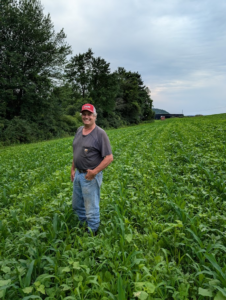
We have not yet been able to observe results due to a re-adjustment with our project timeline due to weather. However, in 2024 we were able to start over and were successful in getting all the planned crops in the ground at Cleveland Farm. Additionally, we were able to modify the project a bit and get an additional planting completed at Dorset Peak Sheep & Cattle Co.
Education & Outreach Activities and Participation Summary
Fall meeting of the DBIC farmer cohort (9/11/24) to give update about SARE project progress
Participation Summary:
- 2023 - A consultation with the neighboring dairy up the road (Larson Farm, Wells, VT) who is also using the ripsower implement to seed diverse forb species into their pastures. We have visited each other's farms and shared equipment for our plantings. While our projects are different, we have some elements in common and we have been able to share information and compare what we are doing (consult with 2 farmers)
- The NE Dairy Business Innovation Center farmer cohort that I am a part of, met here on the farm in July 2023. Cheryl and Abe (consultants) were here as well and we were all able to see and have a conversation about stage 1 of the project which involved planting a spring multi-species cover crop in a 5-acre corn field. This mix of annual ryegrass, sorghum-sudan, phaecelia, cow pea, buckwheat, and clover was planted June 11. Considering the rain that started in late June, the crop yielded well, however we lost some nutrients with all the precipitation. The crop was harvested in late July and a forage sample was taken from the wrapped baleage in late October. Photos of this farmer meeting are attached here. (5 farm businesses in cohort)
- Our farmer cohort met on January 12, 2024 and discussed the 2023 results of the project, where we landed, and plans for the upcoming 2024 season. Since the gamagrass and cup plant could not be planted in the fall due to excessive precipitation, we are discussing ideas for getting these species established in 2024. I had 2 moderately successful crops of diverse covers, which in addition to providing feed crops, conditioned my soil. (increased to 6 farm businesses in cohort)
- Hosted a SARE-funded agronomy training for VT and regional service providers June 18, 2024 (Agronomic Principles for Hayland and Pasture Mgt), where approximately 15 service providers came to the farm and heard about the SARE farmer grant and the progress and challenges to date.
- Farmer cohort met on September 11, 2024 and gave an update on the SARE project (now 7 farm businesses in the project)
-
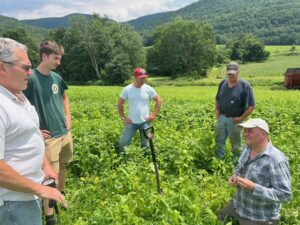
Discussion of conditioning spring cover crop quality (2023) 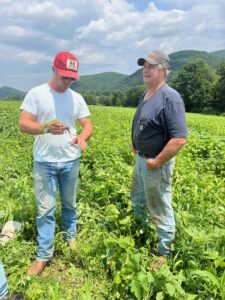
Looking at root development and glomulin on annual ryegrass (2023) 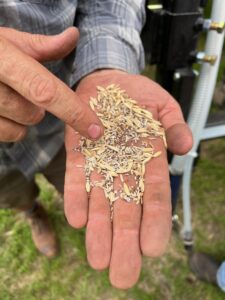
Diverse cover crop seed mix (2023) 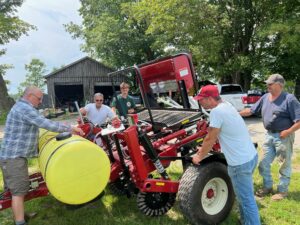
Going over the parts and use of the ripsower implement (2023) 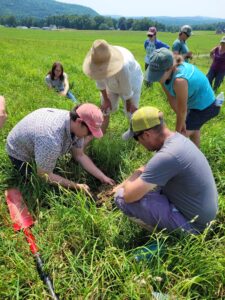
Agronomy training attendees looking at soil characteristics at Cleveland Farm (2024) 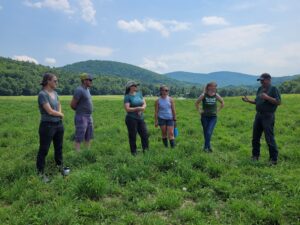
Scott and Cheryl (right) leading discussion about the SARE project
Learning Outcomes
I am working on this project in conjunction with the work I am doing with the NE DBIC cohort I am a member of. Most of our change in knowledge is in regards to planting diverse seed mixes that includes species we have not planted before - for example, Phacelia. When our group met, we had a lengthy discussion whether I should bale, chop or graze this crop. In the end, due mostly to weather and soil conditions, I chose to harvest this crop as round bale silage. Due to maturity, and likely nutrient loss from precipitation, the forage test results weren't ideal. However, I was able to then plant a second cover of oat, pea and other species in August and harvest that as well. This was all leading up to planting the gama grass and cup plant in November with the ripsower (to be planted late for vernilization). However, due to the excessive rains that lasted from July thru the end of the year, soil conditions did not allow for this planting. As a result we (as a farmer group and with Cheryl and Abe) re-setting our plan for 2024. This may involve using a gama grass seed that does not need to be overwintered. There are not clear or developed protocols for what we are doing, so my and the other farmers knowledge and awareness is ongoing with this project. And the attitude is that we need to re-figure and adapt as the weather presents challenges to our original plan.